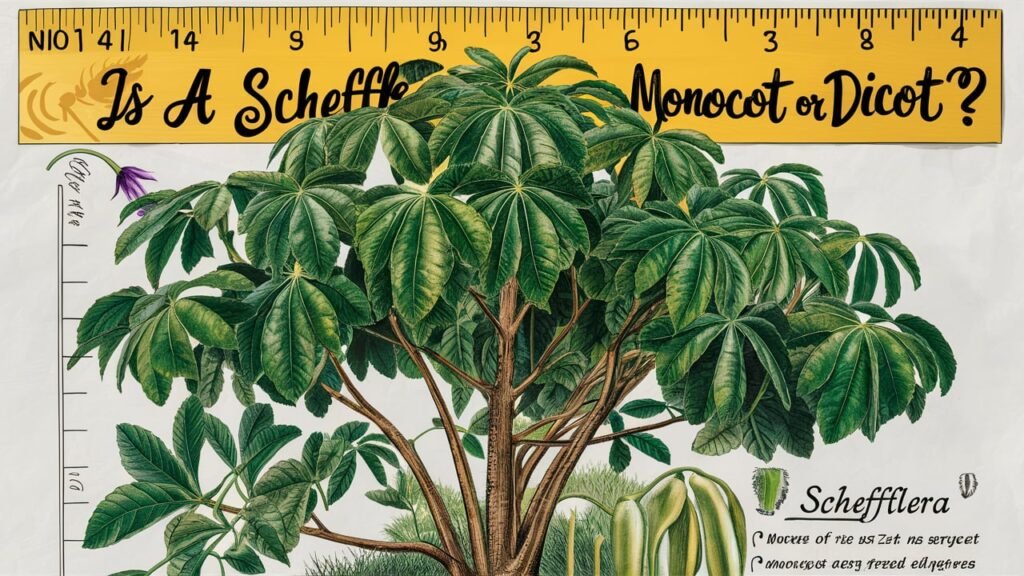The Schefflera plant, known for its lush, umbrella-shaped leaves and versatility as both an indoor and outdoor plant, is a fascinating member of the plant kingdom. However, when exploring its botanical classification, the question arises: Is Schefflera a monocot or dicot? In this comprehensive article, we will explore the defining characteristics of monocots and dicots, examine where Schefflera fits in, and provide insights into identifying its type.
Understanding Monocots and Dicots
To determine whether Schefflera is a monocot or dicot, we must first understand these two major classifications of flowering plants, also known as angiosperms.
What Are Monocots?
Monocots, short for monocotyledons, are plants that possess a single cotyledon (seed leaf) in their seeds. They are characterized by the following traits:
- Leaf Venation: Monocots typically have parallel veins running through their leaves.
- Root System: They have a fibrous root system with no prominent central root.
- Flower Structure: Monocot flowers often have petals and floral parts in multiples of three.
- Stem Structure: Vascular bundles in monocots are scattered throughout the stem.
- Examples: Common monocot plants include grasses, lilies, orchids, and corn.
What Are Dicots?
Dicots, or dicotyledons, have two cotyledons in their seeds. Their defining features include:
- Leaf Venation: Dicots display a net-like or reticulated venation pattern.
- Root System: They typically have a taproot system with a main root and smaller branching roots.
- Flower Structure: Floral parts are usually in multiples of four or five.
- Stem Structure: In dicots, vascular bundles are arranged in a circular pattern.
- Examples: Roses, sunflowers, beans, and oak trees are classic examples of dicots.

Schefflera: Monocot or Dicot?
Schefflera, a genus in the family Araliaceae, is classified as a dicot. This classification is based on its structural and developmental traits, which align with the characteristics of dicotyledonous plants.
Key Characteristics of Schefflera as a Dicot
- Leaf Venation: The leaves of Schefflera exhibit a reticulated venation pattern, a hallmark of dicots. This pattern is evident in the intricate network of veins that spread throughout its broad leaves.
- Root System: Schefflera plants develop a prominent taproot system, with a main root anchoring the plant and smaller lateral roots branching off.
- Stem Structure: In Schefflera, vascular bundles are organized in a ring-like pattern within the stem, another feature indicative of dicots.
- Flower Morphology: Though not commonly observed in indoor Schefflera plants, their flowers, when present, generally display parts in multiples of four or five, consistent with dicot characteristics.
What Type of Schefflera?
The Schefflera genus comprises several species, each with unique traits. Some of the most common types include:
Schefflera Arboricola (Dwarf Umbrella Tree)
This is a smaller variety of Schefflera, often grown indoors as a houseplant. Its compact size and glossy, palmate leaves make it a popular choice for interior spaces.
Schefflera Actinophylla (Umbrella Tree)
Larger and often grown outdoors in tropical climates, this species is known for its impressive height and larger leaves. It is a favorite for landscaping in warm regions.
Schefflera Elegantissima (False Aralia)
Characterized by slender, serrated leaves, this variety offers a more delicate appearance and is often used as a decorative plant.
Each type of Schefflera shares the core dicot features, with variations in size, leaf structure, and growing conditions.

How to Tell if a Tree is a Monocot or Dicot
Identifying whether a plant is a monocot or dicot requires observing several characteristics:
- Examine the Leaves: Check the vein pattern. Parallel veins suggest a monocot, while a net-like pattern indicates a dicot.
- Inspect the Roots: Look for a taproot system (dicot) or a fibrous root system (monocot).
- Count the Flower Parts: Observe the number of petals or other floral parts. Multiples of three point to a monocot, while multiples of four or five suggest a dicot.
- Analyze the Stem: Cross-section the stem to see the arrangement of vascular bundles. A circular arrangement denotes a dicot, while scattered bundles indicate a monocot.
By applying these criteria, it becomes clear that Schefflera, with its reticulated leaves, taproot, and circular vascular bundles, is a dicot.
Common Monocot and Dicot Crop Plants
Examples of Monocots
- Rice (Oryza sativa): A staple food crop with parallel-veined leaves and a fibrous root system.
- Wheat (Triticum aestivum): Another essential cereal crop classified as a monocot.
- Bananas (Musa spp.): Known for their fibrous roots and parallel-veined leaves.
Examples of Dicots
- Tomatoes (Solanum lycopersicum): These plants have reticulated venation and a taproot system.
- Soybeans (Glycine max): Widely cultivated for their seeds, which have two cotyledons.
- Cotton (Gossypium spp.): A dicot plant used extensively in the textile industry.

FAQs
Is Schefflera a monocot or a dicot?
Schefflera is a dicot due to its reticulated leaf venation, taproot system, and the circular arrangement of vascular bundles.
What type of Schefflera is most common?
The most common types are Schefflera Arboricola (dwarf umbrella tree) and Schefflera Actinophylla (umbrella tree).
How can you tell if a tree is a monocot or dicot?
You can identify a plant’s classification by examining its leaf venation, root system, flower parts, and vascular bundle arrangement.
What crop plants are monocots or dicots?
- Monocots: Rice, wheat, and bananas.
- Dicots: Tomatoes, soybeans, and cotton.
Conclusion
In conclusion, the Schefflera plant is a dicot, showcasing all the defining characteristics of this classification. From its intricate leaf venation to its taproot system and floral structure, Schefflera stands as a textbook example of a dicot plant. Understanding its botanical classification not only enhances our appreciation for this versatile plant but also deepens our knowledge of plant biology.

